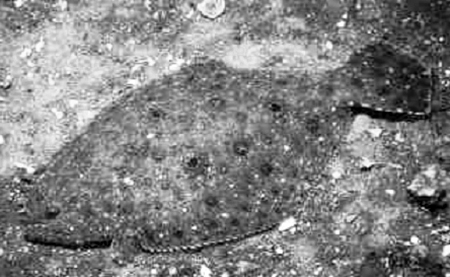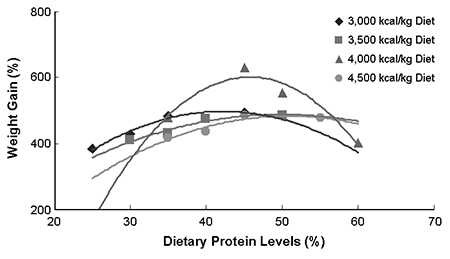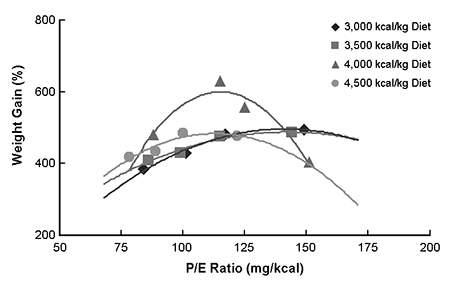Fish on a diet containing 45 percent crude protein at 4,000 kcal/kg utilized feed most efficiently

The olive flounder (Paralichthys olivaceus) is a popular food fish and one of the most important aquaculture species in Korea. Culture operations have expanded extensively since 1990, and production reached 39,628 metric tons (MT) in 2001.
Moist pellet diets based on raw fish are still used in the most intensive inland tank culture systems in Korea. These diets can cause many problems in flounder culture, including disease outbreaks, water pollution, and high production cost. Future development of flounder aquaculture in Korea will require the development of formulated commercial diets.
Feeding trials conducted by the authors to determine the dietary protein level and protein-to-energy (P/E) ratio for optimum growth of juvenile olive flounder provided basic information that could lead to the formulation of extruded pellet diets for this species.
P/E ratios in fish feeds
Protein and energy in fish diets should be kept in balance. Theoretically, a dietary deficiency or excess of digestible energy can reduce growth rates in fish. Energy intake is a basic nutritional requirement, because maintenance of life processes takes priority over growth and other functions. Thus, energy concentration should be one of the most important considerations in diet formulation for fish.
Experimental setup
Sixteen experimental diets were formulated with four protein levels for each of four energy levels:
- 25, 30, 35 and 45 percent crude protein with 3,000 kcal/kg
- 30, 35, 40 and 50 percent crude protein with 3,500 kcal/kg
- 35, 45, 50 and 60 percent crude protein with 4,000 kcal/kg
- 35, 40, 45 and 55 percent crude protein with 4500 kcal/kg.
After a one-week conditioning period, fish averaging about 8.1 g for the diets containing 3,000 or 4,000 kcal/kg and 7.2 grams for the diets containing 3,500 and 4,500 kcal/kg were randomly distributed at 15 fish per tank. Each diet was fed on a dry-matter basis to fish in three randomly selected tanks at 3 to 5 percent of total wet body weight per day for eight weeks.
Results

The weight gains of olive flounder fed the experimental diets are shown in Fig. 1. Weight gains from fish fed the diets containing different protein-to-energy (P/E) ratios are shown in Fig. 2.
3,000-kcal diets
For the 3,000-kcal diets, weight gain and feed efficiency of fish fed the 35 percent and 45v-protein diets were significantly higher than those for fish fed 25 percent and 30 percent diets. However, there were no significant differences in weight gain and feed efficiency between fish fed 35 percent and 45 percent protein diets.
3,500-kcal diets
Weight gain and feed efficiency for fish in the 3,500-kcal regime fed diets with 40 percent and 50 percent crude protein were significantly higher than those of fish fed 30 percent and 35 percent protein diets. No significant performance differences between fish fed diets of 40 percent and 50 percent protein were found.
4,000-kcal diets

For fish that received 4,000-kcal diets, those fed the 45 percent-protein diet had significantly higher weight gain and feed efficiency than those fed 35 percent, 50 percent and 60 percent crude protein.
4,500-kcal diets
In the group that received 4,500-kcal diets, weight gain and feed efficiency for the fish fed 45 percent and 55 percent crude protein were significantly higher than those of fish fed 35 percent and 40 percent-protein diets. There were no significant differences in weight gain and feed efficiency between the fish fed 35 percent and 45 percent crude protein.
Conclusion
Fish fed the diet containing 45 percent crude protein at 4,000 kcal/kg appeared to utilize feed more efficiently than fish fed the other diets. For maximum weight gain, the optimum dietary protein levels of fish fed 3,000-; 3,500-; 4,000-; and 4,500-kcal/kg diets could be 35 percent, 40 percent, 45 percent and 45 percent, respectively. The optimum protein-to-energy ratios could be 117, 114, 113 and 100 mg protein/kcal, respectively. Therefore, the optimum P/E ratio in diets for olive flounder appear to be 100 to 117 mg protein/kcal.
(Editor’s Note: This article was originally published in the April 2002 print edition of the Global Aquaculture Advocate.)
Now that you've finished reading the article ...
… we hope you’ll consider supporting our mission to document the evolution of the global aquaculture industry and share our vast network of contributors’ expansive knowledge every week.
By becoming a Global Seafood Alliance member, you’re ensuring that all of the pre-competitive work we do through member benefits, resources and events can continue. Individual membership costs just $50 a year. GSA individual and corporate members receive complimentary access to a series of GOAL virtual events beginning in April. Join now.
Not a GSA member? Join us.
Authors
-
Sungchul C. Bai, Ph.D.
Department of Aquaculture
Feeds and Foods Nutrition Research Center
Pukyong National University
Busan, Korea, 608-737[32,114,107,46,99,97,46,117,110,107,112,64,105,97,98,99,115]
-
Kang-Woong Kim, Ph.D.
Department of Aquaculture
Feeds and Foods Nutrition Research Center
Pukyong National University
Busan, Korea, 608-737[114,107,46,99,97,46,117,110,107,112,64,109,105,107,119,107]
Tagged With
Related Posts

Health & Welfare
Dietary organic acids improve gut health, disease resistance in olive flounder
A study evaluated the effects of two organic acid blends on performance, gut health and disease resistance in olive flounder. The dietary organic acids were effective in lowering total gut bacterial counts, gut Vibrio counts and in conferring resistance against Edwardsiella tarda.

Health & Welfare
Korean researchers study protein levels, P:E ratios in olive flounder diets
The authors conducted research to determine the optimum dietary protein levels and protein:energy ratios for different age groups of olive flounders.

Aquafeeds
Natural feed additives enhance rainbow trout performance
Various additives, many of plant origin, have been explored to replace the use of antibiotics in aquafeed. The authors compared the performance of rainbow trout fed diets containing oxytetracycline or mineral additives yellow loess and Song-Gang stone powder.

Health & Welfare
A look at tilapia aquaculture in Ghana
Aquaculture in Ghana has overcome its historic fits and starts and is helping to narrow the gap between domestic seafood production and consumption. Production is based on Nile tilapia.


